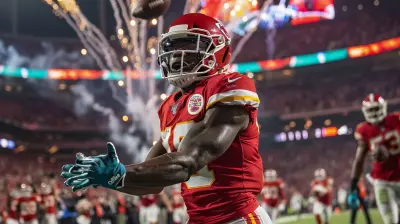How New Rules Are Impacting Youth Sports Development
11 August 2025
Sports have always been a vital part of childhood. Whether it’s kicking a ball in the backyard or competing in school tournaments, youth sports help shape kids both physically and mentally. But in recent years, new rules and regulations have started to change the game—literally!
From safety protocols to eligibility requirements, these changes are redefining how young athletes train, compete, and develop their skills. But is it all for the better? Let’s dive into how these rules are influencing youth sports and what it means for the future of young athletes. 
The Purpose Behind Rule Changes
First off, why are these rule changes happening? Well, the world of sports isn’t what it used to be. With increasing concerns about injuries, burnout, and fairness, governing bodies are stepping in to create a safer and more balanced environment.New rules aim to:
- Prioritize safety by reducing injuries
- Encourage fair competition with stricter eligibility rules
- Promote inclusivity so more kids can participate
- Improve skill development by refining training methods
Seems like a good idea, right? But as with any change, there are pros and cons. Let’s break it down! 
Safety First: Reducing Injuries
One of the biggest reasons behind new sports rules is injury prevention. Let’s be real—nobody wants to see a young athlete sidelined due to a preventable injury.Concussion Protocols and Limits on Contact
Sports like football, hockey, and soccer have introduced strict concussion protocols to protect young players from serious head injuries. Medical professionals now conduct baseline testing, and kids must pass a series of assessments before returning to play.Additionally, some leagues have even adjusted the rules to:
- Limit heading the ball in youth soccer
- Reduce tackling in football for younger age groups
- Enforce stricter penalties for dangerous plays
While this has made the game safer, some argue that limiting contact might affect skill development. After all, how do young athletes learn to handle physicality if they’re shielded from it? 
Equal Opportunities: Encouraging Fair Play
Fairness is another major focus in youth sports rule changes. Organizations are working hard to create a level playing field—literally!Age and Size-Based Divisions
Traditionally, kids have been grouped by age. But what happens when a 12-year-old is twice the size of their classmates? That’s where size-based divisions come in. Some leagues now factor in height and weight along with age to prevent mismatches.The result? Safer and more competitive games. But, some parents argue this system can feel unfair, especially for late bloomers who develop physically later than their peers.
Stricter Eligibility Rules
New rules ensure that only eligible players compete in specific divisions. This prevents “ringers” (older, more experienced players) from dominating games meant for younger kids.However, this also means fewer opportunities for multi-sport athletes who want to play at different levels in different sports. Balancing fairness with flexibility remains a challenge. 
The Rise of Inclusivity in Youth Sports
If there’s one thing that’s changing for the better, it’s inclusivity in youth sports. The old days of “only the best get to play” are fading, and more kids are getting the chance to participate.More Opportunities for Girls in Sports
Title IX laid the groundwork for equal sports opportunities for boys and girls, but recent rule changes are pushing this further. Many schools and leagues are:- Expanding girls' sports programs
- Providing equal access to coaching and training
- Ensuring fair funding for girls’ teams
No longer do young female athletes have to fight for playing time—they’re getting equal footing to chase their dreams.
Adaptive Sports for Kids with Disabilities
Another huge win? The rise of adaptive sports. More leagues are implementing rules that allow kids with disabilities to compete in mainstream sports or have leagues of their own with tailored rules.Whether it’s wheelchair basketball, blind soccer, or inclusive track events, these programs are giving every child the chance to be an athlete.
Changing Practice and Training Methods
Sports training isn’t just about running laps and doing drills anymore. New rules are reshaping how young athletes train, focusing on long-term development rather than immediate success.Limiting Practice Hours to Prevent Burnout
In the past, many young athletes were pushed to train hard, often practicing multiple times a day for hours. While dedication is great, overworking young bodies can lead to burnout and injuries.Now, many sports organizations have capped practice hours to ensure kids:
- Get enough rest and recovery
- Don’t suffer from overuse injuries
- Have time for school and social lives
While some coaches see this as restricting player development, the long-term benefits of avoiding injuries far outweigh the drawbacks.
Emphasis on Multi-Sport Participation
Instead of pressuring kids to specialize in one sport by age 10 (yes, that actually happens), organizations are encouraging multi-sport participation.Why? Because playing multiple sports helps kids:
- Develop a wider range of skills
- Avoid repetitive injuries from overuse
- Maintain long-term interest instead of burning out
This shift is helping young athletes grow holistically, rather than forcing them into a narrow athletic path too early.
The Debate: Are New Rules Helping or Hurting Youth Sports?
Like any big change, these new rules come with mixed opinions. Some parents and coaches worry that:- Reducing contact limits skill development
- Stricter eligibility rules might exclude some kids
- Capping practice hours slows progress
On the other hand, others believe these new regulations are:
- Creating a safer sports environment
- Ensuring fair play for all kids
- Allowing young athletes to enjoy sports rather than treating it like a job
The truth? It’s a balancing act. Sports should be competitive, but they shouldn't come at the cost of safety, fairness, or a child's well-being.
Final Thoughts
There’s no doubt that new rules are shaping the future of youth sports. While some changes may seem restrictive, they ultimately aim to create a safer, fairer, and more inclusive sports environment.At the end of the day, the goal isn’t just to develop better athletes—it’s to develop better kids. Sports should teach teamwork, discipline, and perseverance without risking their health or enjoyment.
So, while these new rules might take some getting used to, they’re paving the way for a brighter and better future in youth athletics. And isn’t that what sports are all about?
all images in this post were generated using AI tools
Category:
New RulesAuthor:

Preston Wilkins
Discussion
rate this article
1 comments
Mallory Jackson
The evolving landscape of youth sports, shaped by new rules, prompts us to reflect on balance: fostering competitive spirit while prioritizing safety and inclusivity. As we navigate this paradox, we must ask ourselves—are we nurturing well-rounded athletes or merely molding future champions in a fleeting game?
September 1, 2025 at 3:23 AM

Preston Wilkins
Great point! Striking the right balance between competition, safety, and inclusivity is crucial for developing not just skilled athletes, but well-rounded individuals.


